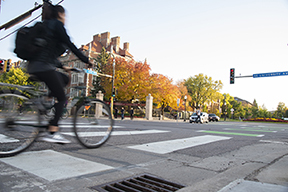Access Across America: Biking 2019
Investments in biking routes continue to yield benefits in U.S. metros

Photo: Michael McCarthy/CTS
Access Across America: Biking 2019 for the first time provides comparisons with accessibility data from the previous year in ranking the 50 largest U.S. metros for connecting workers with jobs via bicycle. Transportation planners and policymakers can use these findings to better coordinate investments in bicycle facilities with the location of jobs and housing to improve job accessibility.
The study incorporates traffic stress and cycling comfort in its evaluation of access to destinations by bicycle. According to the study, low-stress routes are separated bike lanes and paths. Medium-stress routes include all bike infrastructure — low-stress facilities plus on-street unprotected bike lanes, certain shared lanes, and bicyclists mixing with traffic on some non-arterial streets.
Some significant changes were observed in certain cities compared to last year: access to jobs by low-stress bicycle routes in Raleigh increased by a very large 111% and in Boston by 66%, while access to jobs by medium-stress bicycle routes in Charlotte jumped by 54% and in Raleigh by 44%; low-stress access to jobs in Buffalo dropped by 18%, and medium-stress access to jobs in Minneapolis dropped by 7%.
For the average-length bike commute, the Twin Cities ranks No. 10 nationally by bike access to jobs on its bicycle network. On average, Twin Cities workers willing to bike on all bicycle facilities, and in some slower mixed traffic, can reach approximately 57,848 jobs within 30 minutes by bike.
But the bicycle network in the Twin Cities continues to perform among the best nationally of the 50 largest metros when measuring it in relation to the maximum-possible bike access for this metro area (if all routes felt as safe as an off-street path). Specifically, the bike network in the Twin Cities allows workers to reach nearly 73% of the job opportunities theoretically available to cyclists. San Francisco is at 78% and Portland, 74%.
Overall, access to jobs by low-stress bicycle routes in 41 U.S. metros increased and access to jobs via medium-stress bicycle routes in 34 U.S. cities increased. The two main factors that explain significant changes in bicycle access are changes to the bike network and job growth and migration.
Since 2010, the number of bicycle commuters nationwide has increased nearly 22 percent.
More Information
The research is sponsored by the National Accessibility Evaluation Pooled-Fund Study, a multi-year effort led by the Minnesota Department of Transportation and supported by partners including the Federal Highway Administration and additional state DOTs.